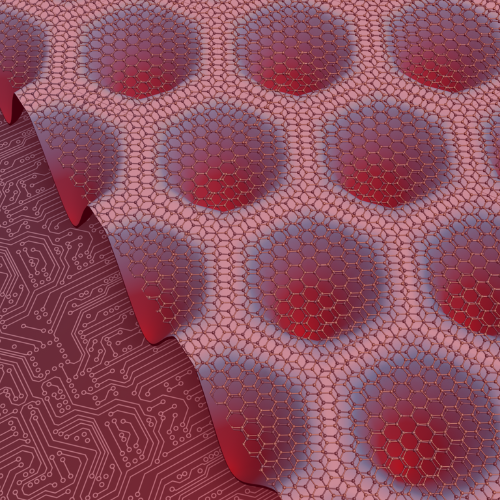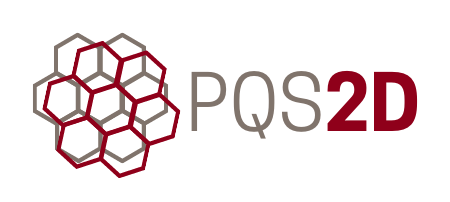Thursday January 16th, 2025 – 2:30pm
Postdoctoral Researcher Kiyoung Jo

Direct sub-wavelength imaging of optoelectronic properties at 2-dimensional semiconductor- metal interfaces
Metal contact to two-dimensional semiconductors is one of the most consequential aspects for achieving high-performance and large-scale electronic and optoelectronic devices. As semiconductor materials are thinned down to the nanometer limit, the contact becomes a dominant factor governing device behavior. However, the chemistry of the contact remains poorly understood because semiconductor-metal contacts are buried interfaces, making them difficult to probe directly. In the first part of this talk, I will present spatial imaging of optoelectronic characteristics of 2D transition metal dichalcogenides (TMD)- metal interfaces. Using a unique metal assisted flipping technique, we are able to access TMD contacts with various metals (Au, Ag and In) to probe their electrical and optical properties. By leveraging scanning probe microscopy coupled with spectroscopy, we performed kelvin probe force microscopy, conductive-AFM, tip-enhanced Raman and photoluminescence spectroscopy. This approach enables concurrent mapping of electrical potential, conductivity, strain and emission spectra at the interface with deep-subwavelength (5-20 nm) spatial resolution. In the second part, we will discuss the excitonic emission within strain-localized WSe2 nanobubbles (50-100 nm in diameters) under different electrical contact environments, such as Schottky and Ohmic contacts. We found the types of the surrounding contact significantly influences the excitonic emission of these nano-emitters, enabling changing the excitonic emission via electrical polarity. At Schottky interfaces, core/shell-like emissions are observed within the nanobubbles, whereas Ohmic contacts exhibit only strain-localized excitons. The strategies presented in this talk will provide insights for investigating diverse nanomaterial systems for applications in nano-electronics and photonics.
Kiyoung Jo earned his PhD degree in Electrical and Systems Engineering at University of Pennsylvania. He is an incoming postdoctoral researcher at Argonne National Laboratory. Before joining Argonne, he worked at Pacific Northwest National Laboratory. His research interests lie in direct probing of nano-optoelectronic properties at mixed-dimensional interfaces using scanning probe microscopy coupled with spectroscopy. He was a Vagelos Institute of Energy Science and Technology Graduate fellow at University of Pennsylvania and a recipient of Dorothy M. Earl S. Hoffman Scholarship (2022) and Nanoscale Science and Technology Division Graduate Student Award (2022) of the American Vacuum Society.


University of Ottawa
Advanced Research Complex (ARC)
25 Templeton Street
Room ARC 233
Previous seminars
| Date | Presenter | Title | Abstract | Links |
|---|---|---|---|---|
| January 25th, 2024 | Assistant Professor Sergio de la Barrera, Department of Physics, University of Toronto | Emergent symmetries and properties in graphene multilayers | Graphene is a beautiful and incredibly versatile platform for investigating emergent electronic phenomena. Confining electrons to two dimensions enhances their influence on one another, and empowers us to alter their environment with external fields and additional layers. Strategic combinations and arrangements of layered materials can yield new physics and surprising electronic properties. This seminar presents how certain combinations lead to superconductivity, magnetism, and topology from materials that have none of these properties on their own, and how they can address essential questions in quantum materials research. | Read more |
| February 29th, 2024 February29th2024 | Postdoctoral Fellow Bowen Yang, Institute for Quantum Computing, University of Waterloo | Probing 2D and Moiré Magnetism through Tunneling Transport | A series of results is presented on a two-dimensional (2D) magnetic material, CrI3, in the atomically thin limit and in a twisted structure, using electrical tunneling transport and/or spectroscopy. In the former, the research group discovers over one million percent of magnetoresistance and obtain a simple microscopic Hamiltonian describing the 2D spin system. In the latter, they find new hysteretic and anisotropic field evolution of the magnetization behavior, arising from coexistence of AFM and FM interlayer interactions. They further uncover two distinct non-volatile spin textures at around 1 degree twist angle with different tunneling resistance that can be switched by magnetic field. | Video link iewseminar |
March 21st, 2024 | Assistant Professor Stephen M. Wu, Department of Electrical and Computer Engineering, University of Rochester | Strain engineering 2D quantum materials | Strain engineering in electronics has been widely utilized over the last 20 years to enhance carrier mobility in most standard Si-based CMOS fabrication processes. These process-induced strain engineering techniques, engineered from the nanofabrication process itself, are simple, reliable, applied device-to-device, and highly scalable down to the nanometer scale. In this talk, Prof. Stephen M. Wu introduces his group work in exploring how process-induced strain engineering translates to the world of 2D materials, and how this may be applied to engineer quantum materials properties. Control over the strain degree-of-freedom in 2D materials opens new pathways for exploration in engineered quantum materials, since strain in weakly-bonded 2D systems can go far beyond strain-engineering in conventional 3D-bonded materials. This is discussed in the context of two different ongoing projects in Prof. Wu group: 2D straintronic phase-change transistors/memristors, and moiré superlattice engineering with strain in twisted and untwisted bilayer 2D heterostructures. | Read more Video link |
| May 13th, 2024 | PhD Student Alina Wania Rodrigues, Quantum Theory Group, University of Ottawa | Designing programmable simulators of strongly correlated electron systems in 2D materials | In this work, we present a Hofstadter’s butterfly spectrum for the magic angle twisted bilayer graphene (MATBG) obtained using an abinitio based multi-million atom tight-binding model. We incorporate a hexagonal boron nitride substrate and out-of-plane atomic relaxation. The effects of a magnetic field are introduced via the Peierls modification of the long-range tight-binding matrix elements and the Zeeman spin splitting effects. A nanoribbon geometry is studied, and the quantum size effects for the sample widths up to 1μ are analyzed both for a large energy window and for the flatband around the Fermi level. For sufficiently wide ribbons, where the role of the finite geometry is minimized, we obtain and plot the Hofstadter spectrum and identify the in-gap Chern numbers by counting the total number of chiral edge states crossing these gaps. Subsequently, we examine the Wannier diagrams to identify the insulating states at charge neutrality. | Read more Video link |
| June 27th, 2024 | Postdoctoral Fellow Ayse Melis Aygar, Electrical Engineering, McGill University | High-Density, Flip-Chip Alkali Doping of Graphene and Observation of the Lifshitz Transition | Experimental setups for charge transport measurements are typically not compatible with the ultrahigh vacuum conditions for chemical doping, limiting the charge carrier density that can be investigated by transport methods. Field-effect methods, including dielectric gating and ionic liquid gating, achieve too low a carrier density to induce electronic phase transitions. To bridge this gap, we developed an integrated flip-chip method to dope graphene by alkali vapor in the diffusive regime, suitable for charge transport measurements at ultrahigh charge carrier density. We introduce a cesium droplet into a sealed cavity filled with inert gas to dope a monolayer graphene sample by the process of cesium atom diffusion, adsorption, and ionization at the graphene surface, with doping beyond an electron density of 4.7 × 1014 cm−2 monitored by operando Hall measurement. The sealed assembly is stable against oxidation, enabling measurement of charge transport versus temperature and magnetic field. Cyclotron mass inversion is observed via the Hall effect, indicative of the change in Fermi surface geometry associated with the Liftshitz transition at the hyperbolic M point of monolayer graphene. The transparent quartz substrate also functions as an optical window, enabling nonresonant Raman scattering. Our findings show that chemical doping, hitherto restricted to ultrahigh vacuum, can be applied in a diffusive regime at ambient pressure in an inert gas environment and thus enable charge transport studies in standard cryogenic environments. | Read more Video link |
| October 3rd, 2024 | Dr. Marek Potemski, LNCMI-Grenoble, CNRS France | Magnons, magnon polarons and spin-entangled optical resonances in semiconducting van der Waals antiferromagnet | Two-dimensional materials beyond graphene offer a remarkable platform for exploring the unique electronic, optical, and magnetic properties of low-dimensional systems. Among these are van der Waals layered magnets, particularly the family of metal phosphorus trichalcogenides (MPX3, where M = Mn, Fe, Co, Ni, and X = S, Se). These MPX3 compounds are semiconducting antiferromagnets with varied spin-ordering configurations. This talk will present the results of magneto-spectroscopy studies (Raman scattering, far- and near-infrared optics, EPR) on several representative layered antiferromagnets, including MnPS3, MnPSe3, FePS3, FePSe3, NiPS3, and CoPS3. The focus will be on identifying the diverse spectra of magnon-gap excitations, exploring magnon-phonon coupling, and discussing the origin of the intriguing spin-entangled optical transitions observed in certain materials in this class. | Read more Video link |
| December 5th, 2024 | Dr. Ziliang Ye, University of British Columbia | Sliding ferroelectricity in rhombohedral MoS2: from slip avalanche to non-volatile optical memory | The tunability in the stacking degree of freedom of van der Waals materials provides a new and powerful approach to engineer their physical properties. Sliding ferroelectricity is one such example that has been observed in artificially stacked boron nitrides and transition metal dichalcogenides, where an electric field can drive one layer of materials to move relative to its neighbors due to an out-of-plane electric polarization arising from coupling between adjacent layers. In this talk, I will show that such a hysteretic phenomenon can also occur in chemically synthesized rhombohedral molybdenum disulfide (3R-MoS2). Due to an unavoidable shear force during crystal exfoliation, avalanches of interlayer slips can happen, resulting in a variety of differently stacked domains with a power-law size distribution. When the external electric field overcomes the local pinning, these pre-existing domain walls can be released for propagation, switching the polarization over a large area of the flake. Thanks to the strong excitonic effects in 3R-MoS2, such atomic-scale motion can be resolved using visible light. The stacking switch induces a large reflectance contrast on an ultrafast timescale, allowing it to be built into non-volatile optical memories with high performances. | Video link |
January 16th, 2025 | Dr. Kiyoung Jo, University of Pennsylvania | Direct sub-wavelength imaging of optoelectronic properties at 2-dimensional semiconductor- metal interfaces | Metal contact to two-dimensional semiconductors is one of the most consequential aspects for achieving high-performance and large-scale electronic and optoelectronic devices. As semiconductor materials are thinned down to the nanometer limit, the contact becomes a dominant factor governing device behavior. However, the chemistry of the contact remains poorly understood because semiconductor-metal contacts are buried interfaces, making them difficult to probe directly. In the first part of this talk, I will present spatial imaging of optoelectronic characteristics of 2D transition metal dichalcogenides (TMD)- metal interfaces. Using a unique metal assisted flipping technique, we are able to access TMD contacts with various metals (Au, Ag and In) to probe their electrical and optical properties. By leveraging scanning probe microscopy coupled with spectroscopy, we performed kelvin probe force microscopy, conductive-AFM, tip-enhanced Raman and photoluminescence spectroscopy. This approach enables concurrent mapping of electrical potential, conductivity, strain and emission spectra at the interface with deep-subwavelength (5-20 nm) spatial resolution. In the second part, we will discuss the excitonic emission within strain-localized WSe2 nanobubbles (50-100 nm in diameters) under different electrical contact environments, such as Schottky and Ohmic contacts. We found the types of the surrounding contact significantly influences the excitonic emission of these nano-emitters, enabling changing the excitonic emission via electrical polarity. At Schottky interfaces, core/shell-like emissions are observed within the nanobubbles, whereas Ohmic contacts exhibit only strain-localized excitons. The strategies presented in this talk will provide insights for investigating diverse nanomaterial systems for applications in nano-electronics and photonics. |

